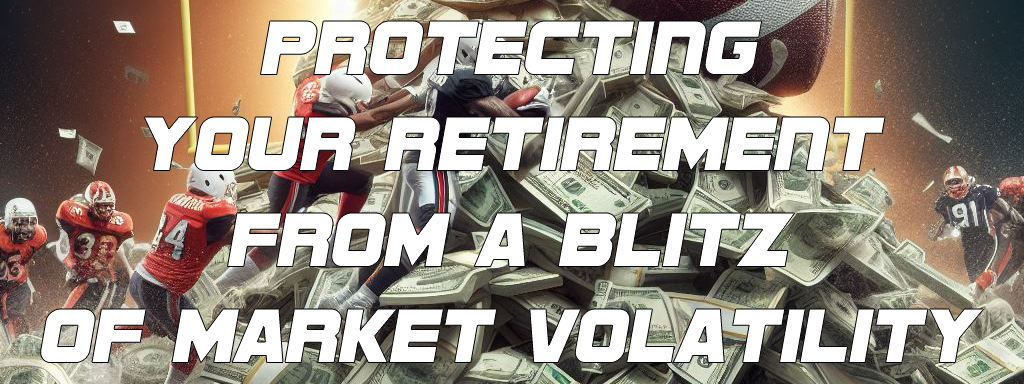
Protecting Your Retirement From a Blitz of Market Volatility
Coaches, our team hopes that the season is going well for each of you and that your teams are gearing up for a strong end to the season.
Recently, in the city championship for 7th and 8th grade teams in a private school league in our hometown of Louisville, Kentucky, two rivals were going at it for the second time this season. The defenses were stingy and did not give up a score in regulation leading to overtime. After each team scored but did not convert their extra point attempt in the first overtime, one team took the lead on the first possession in the second overtime in three plays. Their extra point attempt hit off of the left upright and was unsuccessful. So, the opposing team needed to score a touchdown to tie and convert their extra point to win the game- and the city championship.
On the trailing team’s first play, they lined up with a TE and 3 WRs to the right. The defense adjusted and had a LB, a DE, and two DBs covering the offensive formation. The ball was snapped, but the TE double-teamed the block on the DE which allowed the LB to blitz freely off of the edge jarring the ball loose from the ball carrier enabling a teammate to pick up the fumble to secure the win.
In simple terms, the team on offense did not handle the attack by the defense as well as it could have. The blitz may or may not have been anticipated, but the offense should have blocked the most imminent threat- the blitzing LB- before worrying about the threats that were further away from the ball carrier.
Similarly, for investors and savers for retirement, some threats to our “nest egg” are more obvious and imminent than others. Some investors and savers have more time to battle these threats than others but most retirees don’t always have the luxury of time to ride out the market’s ups and downs. If you’re retired or approaching retirement, you may need to tap your investments for income when markets are volatile, potentially locking in losses that can impair your portfolio for the long term.
Fortunately, planning ahead can go a long way toward helping you protect your retirement when market volatility hits. Here are five strategies to consider:
1. Invest for Income
One way to help reduce your retirement plan’s vulnerability to a volatile market is by considering investing in investment-grade bonds and dividend-paying stocks. Investors may be able to collect regular income from these investments to support spending needs, while leaving the principal investments untouched—at least until the market recovers.
However, there are drawbacks to consider. Some companies may reduce or suspend dividend payments during extended periods of market volatility or economic stress. What’s more, depending on the size of your nest egg and your regular spending needs in retirement, the income you can collect from high-quality bonds and/or dividend-paying stocks may not be sufficient to live on.
2. Consider Purchasing an Annuity
Annuities are another way to provide a reliable stream of income that may reduce or even eliminate the need to sell portfolio assets with high return potential during moments of market stress. What’s more, annuities with guaranteed income-protection benefits provide a set amount of income for life, which means you don’t run the risk of ever outliving your savings.
Of course, there are drawbacks to annuities. For example, the most basic kinds are essentially fixed income instruments that have no potential for growth above specified contractual cash flows.
Variable annuities and fixed index annuities are two options designed to address such drawbacks—for example, by providing investors with some exposure to potential equity-market growth. Both may offer guaranteed income and payout rates that are often higher than the yields on certain equity and fixed-income investments, and so may be well-suited for investors concerned about the stability of their retirement income.
3. Consider “Time-Segmented Bucketing”
Throughout our lives as investors, we regularly use different containers to save for different goals. Funds we need in the near term may be kept in savings or checking accounts, for example, while funds we may need years from now are invested for longer-term growth. This strategy of “time-segmented bucketing” for retirement income isn’t all that different.
With this approach, investors can plan for the early, middle, and late stages of retirement by aligning pools of assets with these different phases. For example, assets that are aligned with short-term needs early in retirement are invested conservatively, in part so that market volatility isn’t as much of a concern as you make withdrawals. Meanwhile, assets aligned with your future spending needs or even gifting plans are invested more aggressively for potential growth.
A principal drawback of time-segmented bucketing is that it can be difficult to implement from a logistical perspective given the complexity of managing multiple asset pools without changing existing account structures.
4. Consider Varying Distribution Amounts Based on Market Performance
Another strategy to consider for protecting your portfolio is tailoring your spending to market performance. When markets dip, you can tighten your belt to avoid selling investments when values are low. This might mean limiting distributions from your portfolio to the dividends and bond coupons your investments generate, tapping other income sources, such as an accruing annuity or other pool of assets, or possibly even exploiting an opportunity for some part-time work. When the market recovers, you can consider increasing spending levels or replenishing outside reserves as the value of your assets potentially begins to grow again.
We tested a spending reduction strategy using hypothetical test cases. In our analysis, the retiree was aged 65 and had a $1 million portfolio invested in 60% stocks and 40% bonds. We assumed she would hike or cut her spending by a rate commensurate with the rise or fall in her funding ratio, a measure of an investor’s retirement readiness that measures the value of retirement assets relative to projected spending.
In this case, when our retiree’s funding ratio dipped below 90% – meaning their assets are equal to just 90% of their planned expenses – she would decrease her spending by 10%. In the event her ratio continued to fall beneath 75%, she would cut her spending another 15%. Our analysis showed that, by varying her spending according to portfolio performance, this investor had a 25% higher portfolio value by the age of 90, than it would be otherwise, implying a similar improvement in her retirement income risk (1).
This approach is not without potential downsides, as aligning your finances with market performance can lead to less predictable spending and lower overall consumption.
5. Ensure Your Portfolio Distributions Are Tax-Efficient
Distributions from qualified retirement plans, such as a 401(k) plan, and traditional IRAs are considered ordinary income by the IRS. Carefully managing how much you take out of taxable, tax exempt and qualified tax deferred accounts—and critically, when you take distributions—is important for if you seek to lessen the tax bite related to such distributions and stretching out your savings. However, individuals must begin taking required minimum distribution (RMDs) from certain employer retirement plans and IRAs, which can substantially limit an investor’s ability to do control distribution timing to minimize tax costs.
One way to get ahead of higher taxes that resulting from RMDs is by deploying an income-smoothing strategy. If you are over age 59 ½, you can consider taking distributions from certain tax-advantaged accounts before distributions from such accounts are required in an effort to lower account balances, so there is less money in those accounts when you reach the age at which you must start taking RMDs. The age at which an individual must start staking RMDs (“RMD Age”) depends on the individual’s date of birth (e.g., if born after 1950, but before 1960, RMD Age is 73) (2). Even though you’ll still need to pay taxes on those distributions made prior to reaching RMD Age, you may avoid having larger chunks of your savings taxed at a higher tax bracket once you reach RMD Age and RMDs are required to be made during that tax year if you time such distributions correctly, thereby potentially lowering your effective tax rate in the RMD years.
One downside of this strategy is that tax rates can change, and if they were to go down in the future, that could adversely impact the tax efficiency of the strategy (on the other hand, if tax rates were to increase, benefits would be magnified).
Reducing Anxiety in Market Volatility
While it can be stressful to see headlines about threats to the value of your nest egg, a volatile market does not necessarily mean danger for your retirement plans. To learn more, you can request a copy of the Global Investment Office report On Retirement: Retirement Income in Volatile Markets and Retirement Income and Sequence of Returns Risk. And ask your legal and tax advisors and your Financial Advisor how you can help safeguard your retirement income against market volatility.
See You In Nashville!
Best wishes for a great end to your season, and we look forward to seeing many of you in the Music City in January. Please let us know if you have any questions or concerns about your own retirement or financial planning after reading this or any of our previous articles. We are happy to meet up at the 2024 Convention.
 Keith Norris |
 Matt Kuerzi |
Article by Morgan Stanley and provided courtesy of Morgan Stanley Financial Advisor
Keith Norris, Senior Vice President and Financial Advisor, and Matt Kuerzi, First Vice President and Financial Advisor, are co-founders of The Derby City Group at Morgan Stanley in Louisville, Kentucky. They have combined over 45 years of experience helping families with their financial planning*. Matt was recognized by Forbes in their first ever list of “Best-In-State Next-Gen Advisors” in 2019 and more recently as a “Best-In-State Wealth Advisor” in 2023. He can be reached directly at (502) 394-4094 or matt.kuerzi@morganstanley.com.
Forbes Top Next-Gen Wealth Advisors
Source: Forbes.com (Awarded June 2019) Data compiled by SHOOK Research LLC based on time period from 3/31/18 – 3/31/19.
Forbes Best-In-State Wealth Advisors
Source: Forbes.com (Awarded April 2023) Data compiled by SHOOK Research LLC based on data as of 6/30/2022.
Branch address: 4969 U.S. Highway 42, Suite 1200, Louisville, KY 40222
* Keith Norris, Senior Vice President, Financial Advisor, experienced in the financial services industry since 1997. Matt Kuerzi, First Vice President, Financial Advisor, experienced in the financial services industry since 2002.
* For more information, please visit https://www.morganstanley.com/articles/protect-retirement-investments-volatile-stock-market?cid=whmt-smfa-protecti-13292. CRC #5441939 (02/2023)
Footnotes
(1) Retirement Income in Volatile Markets, Daniel Hunt, Morgan Stanley, Feb 27, 2019
(2) Specifically, the RMD Age is (a) age 70 ½ for individuals born before July 1, 1949, (b) age 72 for individuals born after June 30, 1949, but before 1951, (c) age 73 for individuals born after 1950, but before 1960, and (d) age 75 for all others – note, there is an apparent drafting error in the statutory language in the SECURE 2.0 Act of 2022 (which was signed into law on December 29, 2022), which makes it unclear when age 75 starts to apply in lieu of age 73, but it appears age 75 is intended to apply if an individual is born after 1959. Individuals born before 1951 are not affected by this change because they’ve already reached RMD Age.
Disclosures:
This material has been prepared for informational purposes only and is not an offer to buy or sell or a solicitation of any offer to buy or sell any security/instrument, or to participate in any trading strategy.
The securities/instruments discussed in this material may not be appropriate for all investors. The appropriateness of a particular investment or strategy will depend on an investor’s individual circumstances and objectives. Morgan Stanley Wealth Management recommends that investors independently evaluate specific investments and strategies, and encourages investors to seek the advice of a financial advisor.
When Morgan Stanley Smith Barney LLC, its affiliates and Morgan Stanley Financial Advisors and Private Wealth Advisors (collectively, “Morgan Stanley”) provide “investment advice” regarding a retirement or welfare benefit plan account, an individual retirement account or a Coverdell education savings account (“Retirement Account”), Morgan Stanley is a “fiduciary” as those terms are defined under the Employee Retirement Income Security Act of 1974, as amended (“ERISA”), and/or the Internal Revenue Code of 1986 (the “Code”), as applicable. When Morgan Stanley provides investment education, takes orders on an unsolicited basis or otherwise does not provide “investment advice”, Morgan Stanley will not be considered a “fiduciary” under ERISA and/or the Code. For more information regarding Morgan Stanley’s role with respect to a Retirement Account, please visit www.morganstanley.com/disclosures/dol. Tax laws are complex and subject to change. Morgan Stanley does not provide tax or legal advice. Individuals are encouraged to consult their tax and legal advisors (a) before establishing a Retirement Account, and (b) regarding any potential tax, ERISA and related consequences of any investments or other transactions made with respect to a Retirement Account.
Equity securities may fluctuate in response to news on companies, industries, market conditions and general economic environment. Companies paying dividends can reduce or stop payouts at any time.
Bonds are subject to interest rate risk. When interest rates rise, bond prices fall; generally the longer a bond’s maturity, the more sensitive it is to this risk.
Morgan Stanley Smith Barney LLC offers insurance products in conjunction with its licensed insurance agency affiliates.
Morgan Stanley Smith Barney LLC offers insurance products in conjunction with its licensed insurance agency affiliates.
Variable annuities are sold by prospectus only. The prospectus contains the investment objectives, risks, fees, charges and expenses, and other information regarding the variable annuity contract and the underlying investments, which should be considered carefully before investing. Prospectuses for both the variable annuity contract and the underlying investments are available from your Financial Advisor. Please read the prospectus carefully before investing.
Hypothetical results are for illustrative purposes only and are not intended to represent future performance of any particular investment. Your actual results may differ. The principal value and investment return of an investment will fluctuate with changes in market conditions, may be worth more or less then original cost. Forward-looking statements are based on assumptions that may not be realized.
© 2023 Morgan Stanley Smith Barney LLC, Member SIPC.
CRC 6080794 11/2023
For more information about the AFCA, visit www.AFCA.com. For more interesting articles, check out The Insider and subscribe to our weekly email.
If you are interested in more in-depth articles and videos, please become an AFCA member. You can find out more information about membership and specific member benefits on the AFCA Membership Overview page. If you are ready to join, please fill out the AFCA Membership Application.
















